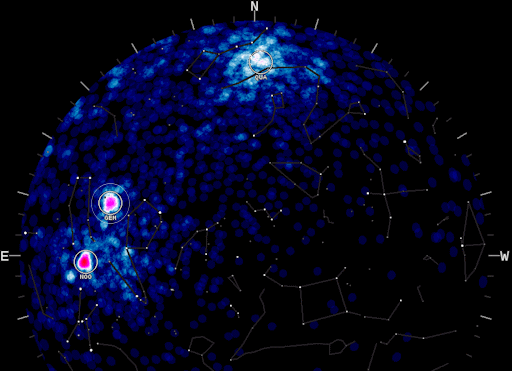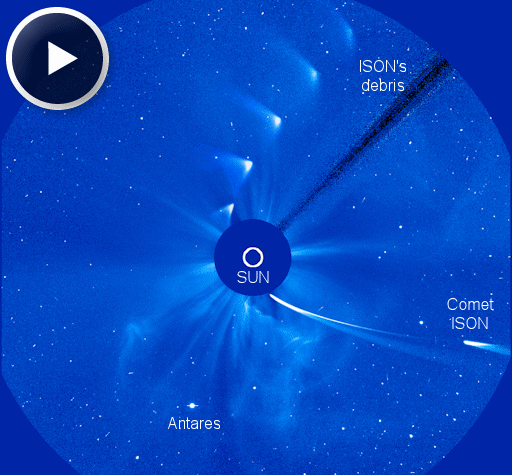When is the best time to see auroras? Where is the best place to go? And how do you photograph them? These questions and more are answered in a new book, Northern Lights - a Guide, by Pal Brekke & Fredrik Broms. | | |
MOSTLY QUIET: With no sunspots actively flaring, the Earthside of the sun is quiet. However, two sunspots (AR1908 and AR1909) have 'beta-gamma' magnetic fields that harbor energy for moderately strong eruptions. NOAA forecasters estimate a 25% chance of M-class solar flares on Dec. 3rd. Solar flare alerts: text, voice
GEMINID METEOR SHOWER: Earth is entering a stream of debris from rock comet 3200 Phaethon, source of the annual Geminid meteor shower. Our planet is just dipping into the outskirts of the debris zone now, so visual meteor rates are low. Nevertheless, the Canadian Meteor Orbit Radar (CMOR) is starting to pick up echoes from meteoroids. This all-sky radar map from Dec. 2nd shows activity from shower's radiant in the constellation Gemini:

"The data processing for the last 24 hours of CMOR data has just finished and the Geminids, still ten days from their maximum, are very clearly visible," reports Prof. Peter Brown of the University of Western Ontario, which operates the radar.
The shower won't peak until Dec. 13-14 when Earth passes through the core of the debris stream, but Brown thinks observers should start looking now. "Glare from the nearly-full Moon will interfere with the Geminid's mid-December maximum," he says. "This week, however, the Moon is new. Observers should be starting to see activity from this very strong shower." Observing tip: The best time to look is during the hours between midnight and dawn when the constellation Gemini is high in the sky. Meteor alerts: text, voice
RARE V-SHAPED SUN HALO: At the end of Thanksgiving Day when the sun was setting over Sumterville, Florida, Paula Phillips took a break from her meal, stepped outside and saw something odd--a pair of luminous 'Vs' in the deepening twilight:

"I've never seen anything like this before," says Phillips. "I photographed the phenomenon with a simple small Samsung camera."
They're sun halos, caused by sunlight shining through ice crystals. Atmospheric optics expert Les Cowley explains:
"These two ‘V’ shaped halos, one rare and one common, change shape dramatically as the sun climbs," he says. "Near sunrise or sunset is the only time to catch them like this. The lower ‘V’ is an upper tangent arc from horizontal hexagonal prisms of ice. The upper one is a rare sunvex Parry arc from similar crystals that - strangely – are fixed so that two prism faces are always horizontal. In the full-sized image, we also see just a trace of a 22o halo and stretching upwards from the sun a sun pillar."
"I find it odd that I saw this in Florida!" continues Phillips. Yet Florida has ice crystal, too. The atmosphere 5 to 10 km above the Sunshine State is always cold enough for water to freeze.
"Florida and other warm places get plenty of halos--some of them exceedingly rare," says Cowley. "Look for them everywhere, winter and summer."
Realtime Space Weather Photo Gallery
COMET ISON, R.I.P.: Following its Thanksgiving Day brush with solar fire, sundiving Comet ISON is now just a cloud of dust. Among experts, a consensus is building that the comet broke apart shortly before perihelion (closest approach to the sun). In the movie, note how rapidly the comet fades just before it vanishes behind the occulting disk of the SOHO coronagraph:

After perihelion, the comet emerges as a diffuse remnant of its former self. No one knows for sure what is inside that fan-shaped cloud. Possibilities include a small remnant nucleus or a "rubble pile" of furiously vaporizing fragments. By the end of the day on Nov. 28th, Comet ISON was spent.
As of Dec. 2nd, the cloud of debris is no brighter than a star of approximately 8th magnitude. Experienced astrophotographers might be able to capture the comet's fading "ghost" in the pre-dawn sky of early December, but a naked-eye spectacle is out of the question.
Realtime Comet ISON Photo Gallery
Realtime All-Comet Photo Gallery
Realtime Aurora Photo Gallery
Every night, a network of
NASA all-sky cameras scans the skies above the United States for meteoritic fireballs. Automated software maintained by NASA's Meteoroid Environment Office calculates their orbits, velocity, penetration depth in Earth's atmosphere and many other characteristics. Daily results are presented here on Spaceweather.com.
On Dec. 3, 2013, the network reported 18 fireballs.
(17 sporadics, 1 November omega Orionid)

In this diagram of the inner solar system, all of the fireball orbits intersect at a single point--Earth. The orbits are color-coded by velocity, from slow (red) to fast (blue). [Larger image] [movies]
Potentially Hazardous Asteroids (
PHAs) are space rocks larger than approximately 100m that can come closer to Earth than 0.05 AU. None of the known PHAs is on a collision course with our planet, although astronomers are finding
new ones all the time.
On December 3, 2013 there were 1443 potentially hazardous asteroids.
Notes: LD means "Lunar Distance." 1 LD = 384,401 km, the distance between Earth and the Moon. 1 LD also equals 0.00256 AU. MAG is the visual magnitude of the asteroid on the date of closest approach. | | The official U.S. government space weather bureau |
| | The first place to look for information about sundogs, pillars, rainbows and related phenomena. |
| | Researchers call it a "Hubble for the sun." SDO is the most advanced solar observatory ever. |
| | 3D views of the sun from NASA's Solar and Terrestrial Relations Observatory |
| | Realtime and archival images of the Sun from SOHO. |
| | from the NOAA Space Environment Center |
| | the underlying science of space weather |

